How to transplant peonies in spring and autumn to a new place: rules for dividing and replanting bushes
All florists with some frequency need to transplant and propagate various plants. This time, if you already got to this material, you most likely need to plant or transplant peonies to another place. Right?
Well, this procedure is not complicated, but you need to know some nuances.
Next, we will carefully and in detail figure out why, when and how to properly transplant and divide peonies.
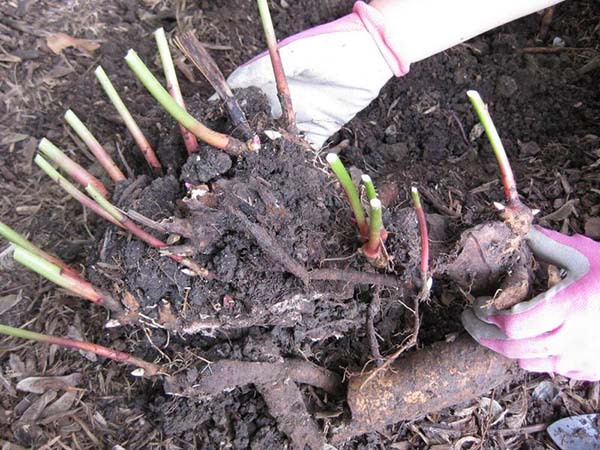
Content
- 1 Why and why you need to transplant peonies
- 2 When is it better to transplant peonies: in spring or autumn, is it possible in summer
- 3 How to transplant peonies to a new place: site preparation rules
- 4 How to transplant (divide) peonies: step by step instructions
- 5 Peony care after transplant
- 6 Why peonies do not bloom or planting errors (transplant)
Why and why you need to transplant peonies
It is quite obvious why we plant flowers - to bloom beautifully. So, peonies are transplanted and planted with the aim of rejuvenating them, and therefore returning their abundant flowering.
The fact is that when the bushes overgrow and thicken, the flowers on such peonies become noticeably smaller (they stop being so lush) and lose their colors. Why? It's very simple: the plant begins to lack nutrition. Thus, we can say that the peony literally requires its forced division and planting.
By the way! Thanks to transplanting and dividing, you can also find rotting roots in time.
Despite the fact that peonies are not very fond of frequent migrations to new places, it is advisable to transplant herbaceous peonies every 4-5 years, tree-like ones - 5-6 years (although it is tree-like ones that can sit quite successfully and bloom well in one place up to 10-15 years ).
Of course, you can divide the bushes less often, but it will be trivially more difficult to do, because they grow very much and you can hardly do without an assistant.
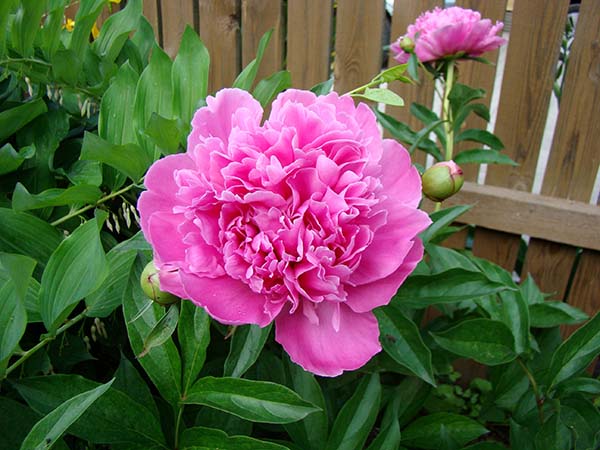
When is it better to transplant peonies: in spring or autumn, is it possible in summer
It is believed that peonies are best planted, as well as transplanted (transplanted), in the fall. It is then that they are guaranteed to take root well and will bloom the next year (although it is advisable not to let them bloom so that the plants grow more powerful roots).
As for the approximate dates, the autumn transplant can be started at the end of summer, i.e. from about mid-August to October (depending on the climate in your region). So, in the Middle Lane, it is advisable to carry out the procedure in September, and in the South of Russia - possibly in October).
The main thing is that before the first frost there should be enough time, 30 days (i.e. a month), so that the peonies have time to take root and take root in a new place.
But in the spring, according to some gardeners, it is extremely undesirable to transplant peonies, because the bushes will take root for a long time and hurt. The fact is that during the spring transplant, the suction roots will inevitably break off, and the development of the peony will be greatly inhibited. Leaves will grow only at the expense of the tuber, which will greatly deplete it. And in the fall, on the contrary, after planting, the suction roots begin to grow back, and the leaves no longer grow.
However! On the Internet, you can find many opposite reviews, proving that peonies can be transplanted in the spring: “In the spring I divided and transplanted, it's okay, they bloom. Peonies all their life in the villages grew, bloomed, and no one looked after them. In the best case, they will throw manure. "
As for the timing of the spring transplant, then, as in the fall, it is advisable to have time to transplant peonies earlier, while the weather is still cool, i.e. approximately in April (relevant for the Central strip - Moscow region). In this case, you need to have time until the plant is just starting to grow.
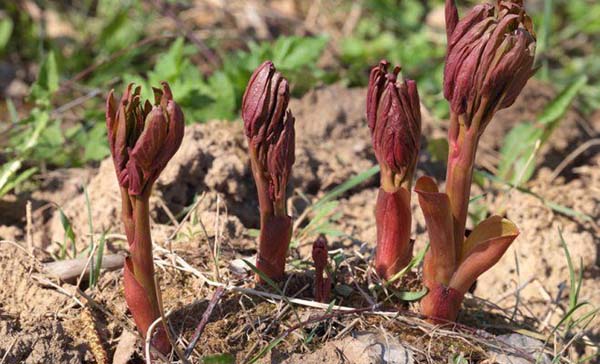
Should you replant in summer? An autumn transplant is recommended only after plants withbuds are formed for the next year. In other words, summer is not the best time for transplanting, especially during flowering.
However, very often the transplant has to be performed, so to speak, out of necessity (for example, in the case of redevelopment of the site) and the availability of free time. Actually, if everything is done correctly, then peonies will be able to take root perfectly both after the autumn and after the spring transplant.
Video: spring transplant of peonies
How to transplant peonies to a new place: site preparation rules
In order for the transplanted peony bushes to take root well in a new place, you must again choose the right place for them in your estate. And the most important thing is to prepare the planting hole well, including filling it with fertile soil, applying fertilizers.
Planting site and soil
In order for the peony to safely take root after transplantation, begin to actively grow and develop, and then please you with lush flowering, you must definitely choose a suitable place for its placement, which must meet the following requirements:
- Well lit (have enough sunlight), although in light partial shade, the shrub also blooms well. It is optimal if in the afternoon in the afternoon (that is, in the very heat) peonies will be in shade, and the rest of the time - in the sun (preferably in the morning - before lunch). If you plant a shrub in a too shady place, then the stems of the peony will begin to stretch out and inflorescences become smaller. Or flowering will stop altogether.
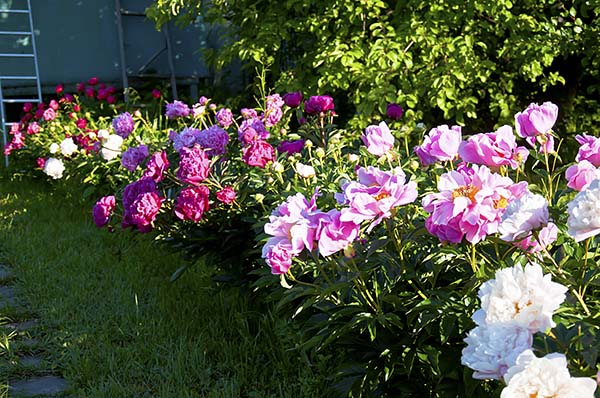
Advice! Do not plant peonies between or under sprawling trees or overgrown shrubs that will constantly shade flower bushes. Although, if you plant on the south side (southwest or east), then this is perfectly acceptable. But not from the north!
- The plot must beprotected from drafts and strong windsand also havegood air circulationthat should not stagnate.
- In no case do not plant peonies in damp places... The plant is very prone to getting wet. Accordingly, it is not recommended to place seedlings on an area with very low groundwater levels (less than 70-80 cm from the surface). This arrangement negatively affects the roots of the peony - they begin to rot, which leads to disease and death.
Alternatively, you can plant peonies in tall beds.
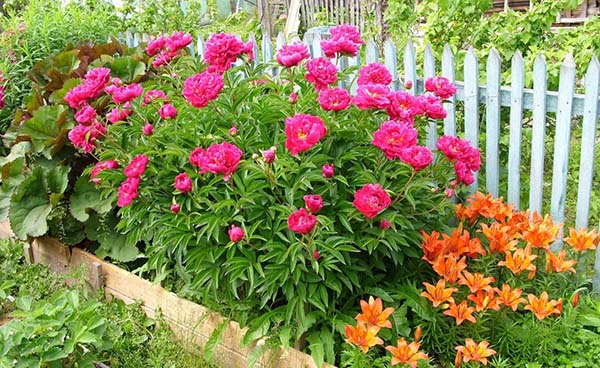
- Plant peonies beautifully together with lilies, phlox, delphiniums, clematis, irises.
Peonies will grow best on neutral in acidity loamy (soil with a high clay content and a significant amount of sand) or sandy loam soils. Such soil is capable of both receiving well and retaining nutrient moisture.
Important! If the soil is acidic, then it is imperative to deacidify it by adding, for example, lime, dolomite flour, wood ash (the latter are also excellent fertilizers).
Planting pit and its filling with nutritious soil
Prepare the landing pit for a spring or autumn transplant of peonies is recommended in advance, at least a month or 2 weeks before the proposed work. This is required so that the earth has time to settle and be thoroughly compacted.
It will be okay if you dig it up right on the day of dividing and transplanting the rhizomes.
The optimal size of the planting pit for planting a peony - 60 centimeters deep and 50-60 cm wide.
The need to dig such a large hole is due to the fact that the root system of the plant grows quite vigorously and can penetrate to a depth of 50 cm, which means that it makes sense to fill it with fertile soil so that the peonies do not need to be fed for several years (2-3) ...
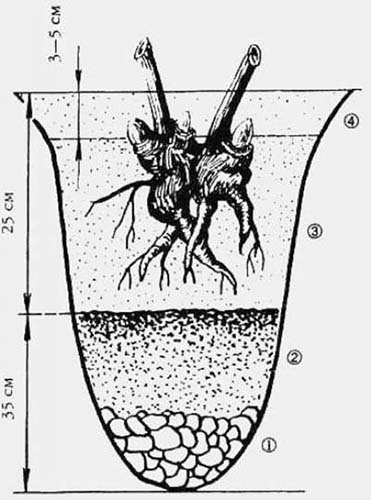
The recommended distance between the bushes is at least 1 meter, and better - 1.5 meters.
Advice! Set aside the upper fertile soil when digging a hole separately, it will still be needed.
Instructions for the correct refueling of the planting pit for peonies:
- As first layer (10-15 cm) on the bottom of the hole should be laid out drainageso that there is no stagnant moisture (especially if you have heavy soil). Broken brick, pebbles or expanded clay are perfect for these purposes.
Important! Drainage is essential in soils with high groundwater levels. peonies are very afraid of getting wet.
- Next, pour on top some sand (5 cm).
- Now you need fertile soil... To do this, it is recommended to take a bucket of good humus or compost (8-9 kg), 80-100 grams superphosphate and 60-70 grams of potassium sulfate (or potassium sulfate), or a glass and a half wood ash (100-150 grams), as well as the top layer of fertile soil left after digging a hole, and mix everything thoroughly.
Advice! Additionally, for greater soil fertility (or instead of superphosphate), you can mix bone or fish meal... The peony really loves to eat a similar composition.

By the way! There is an opinion (controversial, but still) that: “Even without a huge hole, peonies take root well, and no fertilizer should be poured there. But when they get accustomed, then we will feed ”.
How to transplant (divide) peonies: step by step instructions
So, a peony transplant consists of 3 main steps:
- digging the bushes themselves (rhizomes);
- their division (reproduction);
- and direct disembarkation of divisions to new (other) places.
Digging bushes
- Before digging up peonies, many recommend spilling the bushes well with water (2-3 buckets per bush). However, in this case, on the contrary, the bushes will be more difficult to reach (the soil will stick to them), so it is still better not to do this.
- If you are carrying out an autumn transplant of peonies, then you must first prune.
As a rule, it is recommended to cut the stems almost level with the ground. However, it is not necessary to completely cut green foliage, as the peony will continue to eat until the cold weather. And digging a bush with branches is more convenient than without them, isn't it?
Important! You cannot pull on the stems, otherwise you will tear them off along with the buds.
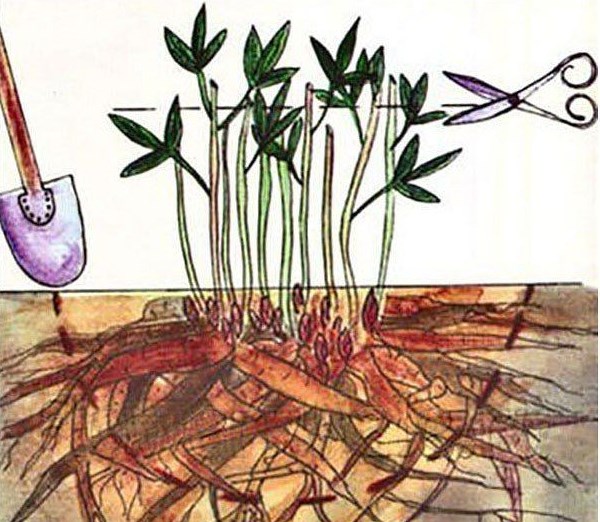
- Next, carefully dig in the bush from all sides (along the perimeter), stepping back from the center by 20-25 centimeters.
It's okay if some of the roots break off, this is practically impossible to avoid.
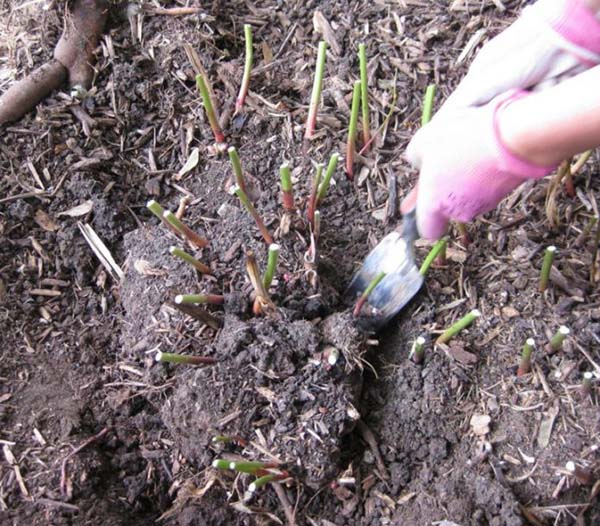
- Rock the bushes well and carefully remove the rhizomes along with the earthy clod.
- Remove from the ground and rinse under running water from a hose so you can divide them.
Division
- Then for 3-6 hours it is necessary to leave the bushes in the shade so that they wither a little, and the roots become more elastic, otherwise they will be too brittle.
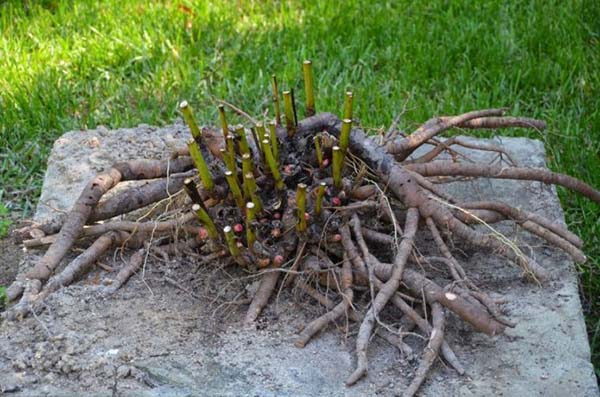
- After the roots have dried up enough, you should start dividing them.
- Carefully divide (if possible with your hands) or cut (with a knife) the rhizomes into several small divisions.
You need to divide very carefully, but you should not be afraid to damage the roots, because the main thing is that you do not damage the kidneys.
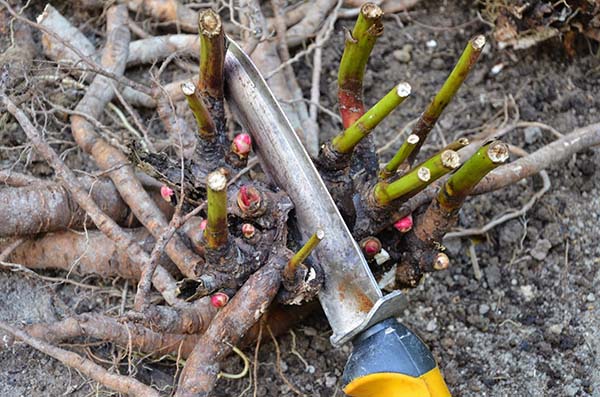
Each division should have 3-5 buds, and the length of the horses should be 15-20 cm. Too long roots should be shortened (cut) so that they can be conveniently placed in the planting pit.
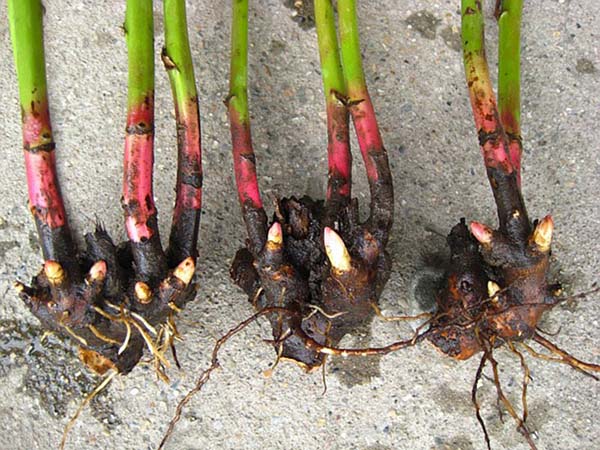
- During division, you also need to carefully examine the rhizomes from all sides for suspicious spots and rot that should be removed (trimmed). Then sprinkle the slices with crushed or activated carbon or grease with brilliant green. In addition, you can place the delenki in a disinfecting solution, for example, in a solution of potassium permanganate (for 20-30 minutes), or etched in the Maxim preparation. And you can additionally dip it into a solution of a root formation stimulator, for example, "Heteroauxin", or powder it with "Kornevin".
Alternatively, you can dip the roots in a clay mash (clay + water to make a mushy or sour cream slurry), into which you can also add copper sulfate (50 grams per bucket) or wood ash.
- All! Delenki are ready to be transplanted to a new flower bed!
Video: dividing peonies - how to properly dig up and divide the rhizomes
Landing at a new location
- We put the parcel in the center of the pre-prepared landing pit.
It is very important to control the deepening of growth points (kidneys). They should be no deeper than 4-5 cm (if the ground is light, then it is possible by 5-6 cm, if heavy, then by 3-4 cm). If you deepen the seedling too much, then the plant may support or simply not bloom. On the contrary, if the seedling is too close to the surface of the earth, then its buds may freeze slightly in winter and it will bloom very weakly.
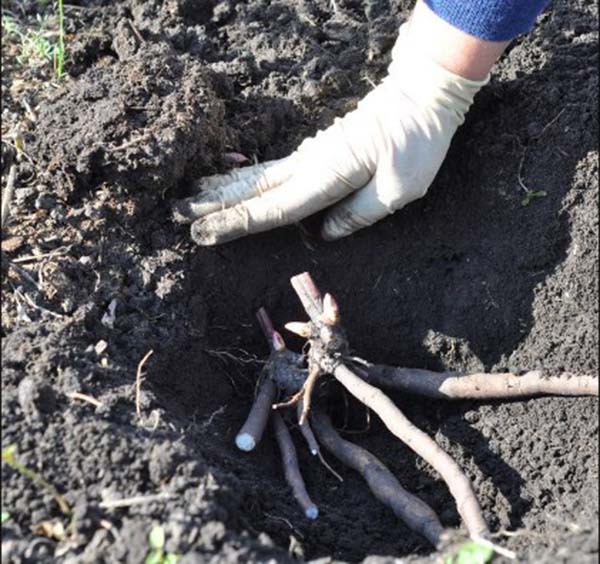
- We fall asleep with fertile soil.
- Then, as gently as possible with our hands (but not with our feet), we press the earth, tamping it.
This will allow the soil to sink better, in other words, the number of possible voids between the roots and the ground will decrease.
- Spill abundantly with water.
- If necessary, add more soil (if it sags).
- If desired, we mulch with compost or peat, sawdust.
Mulch will protect against excessive overheating and cracking of the soil, in other words, it will create optimal conditions for the rapid rooting of the cut.
Video: how to divide an old peony bush - digging, dividing and planting
Peony care after transplant
After transplanting, the plant needs a short period of rest, and then you do everything as before - watering (as the soil dries up), loosen and weed from weeds.
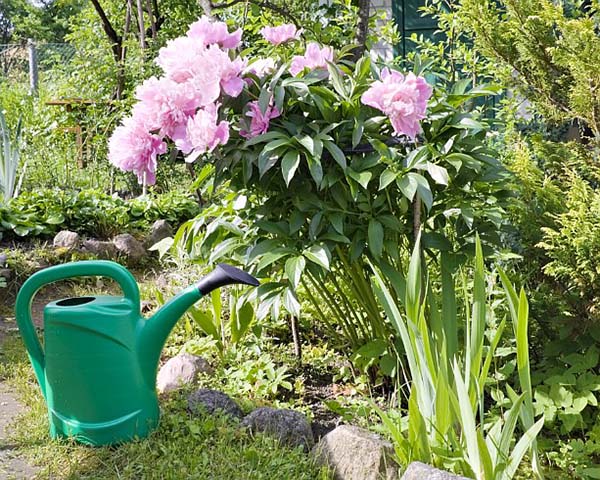
Advice!In the first year after transplanting, you should get rid of the buds that appear (especially with a spring transplant, although also with an autumn one), becauseit is more important for peonies at this moment to build up a powerful root system than to bloom.
Concerning top dressing, then they will not be required in the next 2-3 years, of course, if you have introduced a sufficient amount of nutrients (fertilizers) into the planting pit.
By the way! The site already has a detailed article about feeding peonies in spring.
For the winter should definitely hold pruning peonies (if you carried out a spring transplant, if a winter transplant, then this has already been done).
Also, as one of the measures to prepare for winter is shelter pruned bushes with small layers of fallen leaves.
Note!In general, about what to do with peonies in autumn (how to feed, how to cut and cover) and how to properly prepare them for winter, read in this article.
Why peonies do not bloom or planting errors (transplant)
Very often, novice gardeners are faced with the fact that planted or transplanted peonies poorly or completely stop blooming, namely, the aboveground green mass is growing, and the peduncles are absent.
What are the reasons and what can be done?
- One of the main reasons is deepening of the rhizome during planting... Peony does not tolerate deep planting. The soil level should be 3-4 cm lower (maximum - 5-6) of the root bud, but it should not be placed too high either, because roots can freeze in winter.
- Another relatively popular reason for not blooming is wrong landing... Peonies are in great need of sunlight, so if planted in the shade, they may not bloom due to lack of sun.
Also, peonies do not tolerate acidic soils.
- Landing toosmall division (which begins to bloom magnificently only at the age of 3-4 years).
- Improper or insufficient care - lack or excess of moisture and nutrients (for example, overfed with nitrogen).
To learn more about why peonies may not bloom, you can watch the following video.
Video: why peonies don't bloom
Thus, thanks to the procedure of transplanting and dividing peonies, you can regularly rejuvenate your shrub, and in return it will continue to delight you with lush and bright flowering every year. You will succeed, only the main thing is to transplant according to all the above rules and recommendations.
Video: peony transplant

